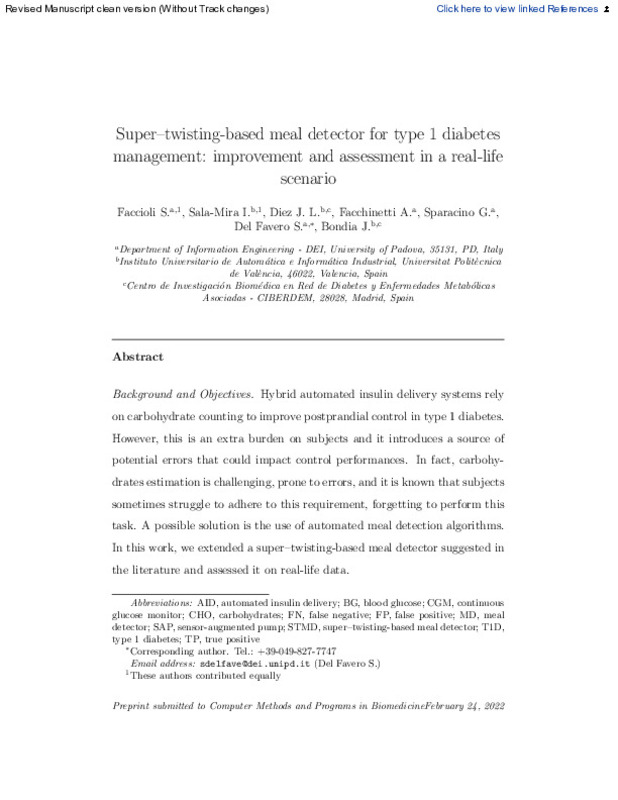JavaScript is disabled for your browser. Some features of this site may not work without it.
Buscar en RiuNet
Listar
Mi cuenta
Estadísticas
Ayuda RiuNet
Admin. UPV
Super-twisting-based meal detector for type 1 diabetes management: Improvement and assessment in a real-life scenario
Mostrar el registro sencillo del ítem
Ficheros en el ítem
| dc.contributor.author | Faccioli, S.
|
es_ES |
| dc.contributor.author | Sala-Mira, Iván
|
es_ES |
| dc.contributor.author | Diez, José-Luís
|
es_ES |
| dc.contributor.author | Facchinetti, A.
|
es_ES |
| dc.contributor.author | Sparacino, G.
|
es_ES |
| dc.contributor.author | del Favero, S.
|
es_ES |
| dc.contributor.author | Bondía Company, Jorge
|
es_ES |
| dc.date.accessioned | 2023-11-29T19:01:18Z | |
| dc.date.available | 2023-11-29T19:01:18Z | |
| dc.date.issued | 2022-06 | es_ES |
| dc.identifier.issn | 0169-2607 | es_ES |
| dc.identifier.uri | http://hdl.handle.net/10251/200345 | |
| dc.description.abstract | [EN] Background and objective: Hybrid automated insulin delivery systems rely on carbohydrate counting to improve postprandial control in type 1 diabetes. However, this is an extra burden on subjects, and it introduces a source of potential errors that could impact control performances. In fact, carbohydrates estimation is challenging, prone to errors, and it is known that subjects sometimes struggle to adhere to this requirement, forgetting to perform this task. A possible solution is the use of automated meal detection algorithms. In this work, we extended a super-twisting-based meal detector suggested in the literature and assessed it on real-life data. Methods: To reduce the false detections in the original meal detector, we implemented an implicit discretization of the super-twisting and replaced the Euler approximation of the glucose derivative with a Kalman filter. The modified meal detector is retrospectively evaluated in a challenging real-life dataset corresponding to a 2-week trial with 30 subjects using sensor-augmented pump control. The assessment includes an analysis of the nature and riskiness of false detections. Results: The proposed algorithm achieved a recall of 70 [13] % (median [interquartile range]), a precision of 73 [26] %, and had 1.4 [1.4] false positives-per-day. False positives were related to rising glucose conditions, whereas false negatives occurred after calibrations, missing samples, or hypoglycemia treatments. Conclusions: The proposed algorithm achieves encouraging performance. Although false positives and false negatives were not avoided, they are related to situations with a low risk of hypoglycemia and hyperglycemia, respectively. | es_ES |
| dc.description.sponsorship | This work was supported by grant DPI2016-78831-C2-1-R funded by MCIN/AEI/10.13039/501100011033 and by "ERDF A way of making Europe"; grant PID2019-107722RB-C21 funded by MCIN/AEI/10.13039/501100011033; the Generalitat Valenciana through FSE funds (grant number ACIF/2017/021); the Italian Ministry of Education, Universities and Research (MIUR) through the project "Learn4AP: Patient-Specific Models for an Adaptive, Fault Tolerant Artificial Pancreas"(SIR initiative, project ID: RBSI14JYM2); the MIUR under the initiative "Departments of Excellence"(Law 232/2016). | es_ES |
| dc.language | Inglés | es_ES |
| dc.publisher | Elsevier | es_ES |
| dc.relation.ispartof | Computer Methods and Programs in Biomedicine | es_ES |
| dc.rights | Reconocimiento - No comercial - Sin obra derivada (by-nc-nd) | es_ES |
| dc.subject | Type 1 diabetes | es_ES |
| dc.subject | Automated insulin delivery system | es_ES |
| dc.subject | Postprandial control | es_ES |
| dc.subject | Meal detection | es_ES |
| dc.subject.classification | INGENIERIA DE SISTEMAS Y AUTOMATICA | es_ES |
| dc.title | Super-twisting-based meal detector for type 1 diabetes management: Improvement and assessment in a real-life scenario | es_ES |
| dc.type | Artículo | es_ES |
| dc.identifier.doi | 10.1016/j.cmpb.2022.106736 | es_ES |
| dc.relation.projectID | info:eu-repo/grantAgreement/AEI/Plan Estatal de Investigación Científica y Técnica y de Innovación 2017-2020/PID2019-107722RB-C21/ES/SOLUCIONES A MEDIDA DEL PACIENTE PARA EL CONTROL DE GLUCOSA EN SANGRE EN DIABETES TIPO 1/ | es_ES |
| dc.relation.projectID | info:eu-repo/grantAgreement/AEI//DPI2016-78831-C2-1-R//SOLUCIONES PARA LA MEJORA DE LA EFICIENCIA Y SEGURIDAD DEL PÁNCREAS ARTIFICIAL MEDIANTE ARQUITECTURAS DE CONTROL MULTIVARIABLE TOLERANTES A FALLOS/ | es_ES |
| dc.relation.projectID | info:eu-repo/grantAgreement/GENERALITAT VALENCIANA//ACIF%2F2017%2F021//AYUDA PREDOCTORAL CONSELLERIA-SALA MIRA/ | es_ES |
| dc.relation.projectID | info:eu-repo/grantAgreement/MIUR//RBSI14JYM2//Learn4AP: Patient-Specific Models for an Adaptive, Fault Tolerant Artificial Pancreas/ | es_ES |
| dc.relation.projectID | info:eu-repo/grantAgreement/MIUR//Law 232%2F2016//Departments of Excellence/ | es_ES |
| dc.rights.accessRights | Abierto | es_ES |
| dc.contributor.affiliation | Universitat Politècnica de València. Escuela Técnica Superior de Ingenieros Industriales - Escola Tècnica Superior d'Enginyers Industrials | es_ES |
| dc.description.bibliographicCitation | Faccioli, S.; Sala-Mira, I.; Diez, J.; Facchinetti, A.; Sparacino, G.; Del Favero, S.; Bondía Company, J. (2022). Super-twisting-based meal detector for type 1 diabetes management: Improvement and assessment in a real-life scenario. Computer Methods and Programs in Biomedicine. 219:1-10. https://doi.org/10.1016/j.cmpb.2022.106736 | es_ES |
| dc.description.accrualMethod | S | es_ES |
| dc.relation.publisherversion | https://doi.org/10.1016/j.cmpb.2022.106736 | es_ES |
| dc.description.upvformatpinicio | 1 | es_ES |
| dc.description.upvformatpfin | 10 | es_ES |
| dc.type.version | info:eu-repo/semantics/publishedVersion | es_ES |
| dc.description.volume | 219 | es_ES |
| dc.identifier.pmid | 35338888 | es_ES |
| dc.relation.pasarela | S\460179 | es_ES |
| dc.contributor.funder | GENERALITAT VALENCIANA | es_ES |
| dc.contributor.funder | AGENCIA ESTATAL DE INVESTIGACION | es_ES |
| dc.contributor.funder | European Regional Development Fund | es_ES |
| dc.contributor.funder | Ministero dell'Istruzione, dell'Università e della Ricerca | es_ES |







![[Cerrado]](/themes/UPV/images/candado.png)

